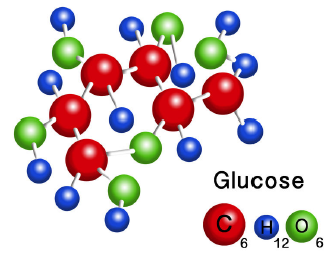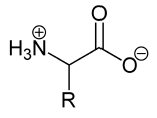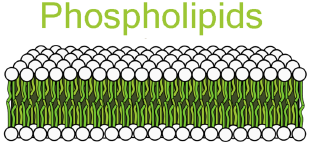Reading: Organic Compounds
Jessica Harwood
Douglas Wilkin, Ph.D.
http://www.ck12.org/saythanks
• Define proteins, carbohydrates, lipids, nucleic acids.
• Recognize the basic structure of organic compounds and explain their basic functions.
• Distinguish the categories of organic compounds, compare and contrast their roles, and analyze the components of each category.
• Summarize in detail the structure and function of the organic compounds, emphasizing the relationship between structure and function.
What makes up a healthy diet?
A healthy diet includes protein, fats, and carbohydrates. Why? Because these compounds are three of the main building blocks that make up your body. You obtain these building blocks from the food that you eat, and you use these building blocks to make the organic compounds necessary for life.
Organic Compounds
The main chemical components of living organisms are known as organic compounds. Organic compounds are molecules built around the element carbon (C). Living things are made up of very large molecules. These large molecules are called macromolecules because “macro” means large; they are made by smaller molecules bonding together. Our body gets these smaller molecules, the "building blocks" or monomers, of organic molecules from the food we eat. Which organic molecules do you recognize from the list below?
The four main types of macromolecules found in living organisms, shown in Table 1.1, are:
1. Proteins.
2. Carbohydrates.
3. Lipids.
4. Nucleic Acids.
TABLE 1.1: The Four Main Classes of Organic Molecules
| Proteins | Carbohydrates | Lipids | Nucleic Acids | |
|---|---|---|---|---|
| Elements | C, H, O, N, S | C, H, O | C, H, O, P | C, H, O, P, N |
| Examples | Enzymes, muscle fibers, antibodies | Sugar, glucose, starch, glycogen, cellulose | Fats, oils, waxes, steroids, phospholipids in membranes | DNA, RNA, ATP |
| Monomer (small building block molecule) | Amino acids | Monosaccharides (simple sugars) | Often include fatty acids | Nucleotides |
Carbohydrates
Carbohydrates are sugars, or long chains of sugars. An important role of carbohydrates is to store energy. Glucose (Figure 1.1) is an important simple sugar molecule with the chemical formula C6H12O6. Simple sugars are known as monosaccharides. Carbohydrates also include long chains of connected sugar molecules. These long chains often consist of hundreds or thousands of monosaccharides bonded together to form polysaccharides. Plants store sugar in polysaccharides called starch. Animals store sugar in polysaccharides called glycogen. You get the carbohydrates you need for energy from eating carbohydrate-rich foods, including fruits and vegetables, as well as grains, such as bread, rice, or corn.

FIGURE 1.1
A molecule of glucose, a type of carbohydrate.
Proteins
Proteins are molecules that have many different functions in living things. All proteins are made of monomers called amino acids ( Figure 1.2) that connect together like beads on a necklace ( Figure 1.3). There are only 20 common amino acids needed to build proteins. These amino acids form in thousands of different combinations, making about 100,000 or more unique proteins in humans. Proteins can differ in both the number and order of amino acids. It is the number and order of amino acids that determines the shape of the protein, and it is the shape (structure) of the protein that determines the unique function of the protein. Small proteins have just a few hundred amino acids. The largest proteins have more than 25,000 amino acids.

FIGURE 1.2
This model shows the general structure of all amino acids. Only the side chain, R, varies from one amino acid to another. KEY: H = hydrogen, N = nitrogen, C = carbon, O = oxygen, R = variable side chain.
![]()
FIGURE 1.3
Amino acids connect together like beads on a necklace. MET, ASN, TRP, and GLN refer to four different amino acids.
Many important molecules in your body are proteins. Examples include enzymes, antibodies, and muscle fiber. Enzymes are a type of protein that speed up chemical reactions. They are known as "biological catalysts." For example, your stomach would not be able to break down food if it did not have special enzymes to speed up the rate of digestion. Antibodies that protect you against disease are proteins. Muscle fiber is mostly protein
It’s important for you and other animals to eat food with protein, because we cannot make certain amino acids on our own. You can get proteins from plant sources, such as beans, and from animal sources, like milk or meat. When you eat food with protein, your body breaks the proteins down into individual amino acids and uses them to build new proteins. You really are what you eat!
Lipids
Have you ever tried to put oil in water? They don’t mix. Oil is a type of lipid. Lipids are molecules such as fats, oils, and waxes. The most common lipids in your diet are probably fats and oils. Fats are solid at room temperature, whereas oils are fluid. Animals use fats for long-term energy storage and to keep warm. Plants use oils for longterm energy storage. When preparing food, we often use animal fats, such as butter, or plant oils, such as olive oil or canola oil. There are many more type of lipids that are important to life. One of the most important are the phospholipids that make up the protective outer membrane of all cells ( Figure 1.5).

FIGURE 1.5
Phospholipids in a membrane, shown as two layers (a bilayer) of phospholipids facing each other.
Nucleic acids
Nucleic acids are long chains of nucleotides. Nucleotides are made of a sugar, a nitrogen-containing base, and a phosphate group. Deoxyribonucleic acid (DNA) and ribonucleic acid (RNA) are the two main nucleic acids. DNA is a double-stranded nucleic acid. DNA is the molecule that stores our genetic information. The singlestranded RNA is involved in making proteins. ATP (adenosine triphosphate), known as the "energy currency" of the cell, is also a nucleic acid.
Summary
• Living organisms are comprised of organic compounds, molecules built around the element carbon.
• Living things are made of just four classes of organic compounds: proteins, carbohydrates, lipids, and nucleic acids.
Review
1. What are the four main types of organic compounds that make up living things?
2. What are the monomers used to make carbohydrates, proteins, and nucleic acids?
3. What are examples of lipids?
4. What are examples of proteins?
